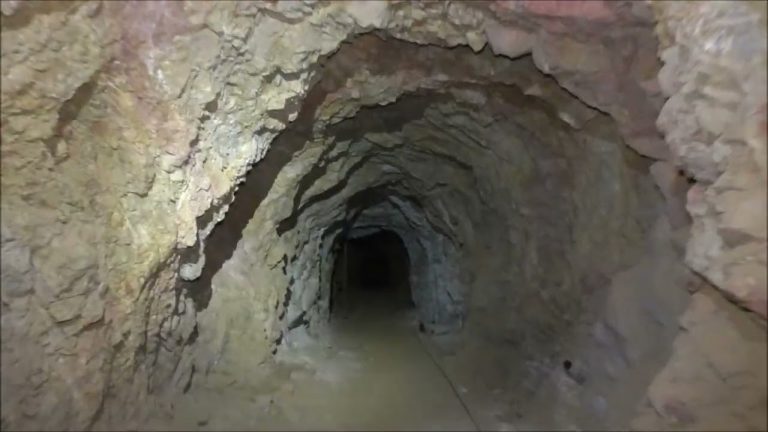Remediation Of Abandoned Gold Mines: A Challenging Task

Table of Contents
Environmental Hazards Posed by Abandoned Gold Mines
Abandoned gold mines leave behind a legacy of environmental damage. The irresponsible practices of the past continue to impact ecosystems and human health today. Addressing these hazards is paramount for successful remediation of abandoned gold mines.
Water Contamination
Acid mine drainage (AMD) is a major consequence of abandoned gold mining operations. The oxidation of sulfide minerals within the mine waste generates acidic water, leaching heavy metals such as arsenic, lead, mercury, and cadmium into nearby water bodies. This contaminated water poses severe risks:
- Impact on Aquatic Life: AMD drastically lowers water pH, making it toxic to fish and other aquatic organisms, disrupting entire ecosystems.
- Threat to Drinking Water Supplies: Contaminated water sources endanger human health, necessitating expensive water treatment processes.
- Agricultural Impacts: Irrigation with AMD-affected water contaminates agricultural land, affecting crop yields and food safety.
Remediation strategies for water contamination include:
- Passive remediation systems: Utilizing wetlands and constructed wetlands to naturally treat AMD through biological processes.
- Active remediation systems: Employing chemical treatments, such as neutralization and precipitation, to remove heavy metals from water.
Soil Contamination
Heavy metal contamination of the soil surrounding abandoned gold mines is another significant environmental concern. These metals accumulate in the soil, hindering plant growth and potentially entering the food chain through bioaccumulation.
- Impact on Plant Growth: Heavy metal toxicity reduces soil fertility, affecting plant health and biodiversity.
- Food Chain Contamination: Contaminated soil can lead to the accumulation of heavy metals in plants and animals, ultimately affecting human health through consumption.
Remediation techniques for soil contamination involve:
- Phytoremediation: Utilizing plants with the ability to absorb and accumulate heavy metals from the soil.
- Soil excavation and replacement: Removing and replacing contaminated soil with clean material, a costly but effective method.
- Microbial remediation: Employing microorganisms to break down or immobilize heavy metal contaminants in the soil.
Air Pollution
Dust generated from abandoned mine shafts, tailings piles, and exposed mine waste poses a significant air pollution risk. This dust often contains hazardous materials, impacting both air quality and human health.
- Respiratory Problems: Inhalation of dust containing heavy metals can cause respiratory illnesses.
- Visibility Reduction: Dust plumes reduce visibility, impacting transportation and potentially affecting local climates.
Mitigating air pollution from abandoned gold mines requires:
- Revegetation: Planting vegetation to stabilize the soil and reduce wind erosion.
- Dust suppression: Applying dust suppressants to reduce dust generation and dispersion.
- Windbreaks: Constructing windbreaks to reduce wind speed and minimize dust transport.
Technical Challenges in Remediation
The technical complexities associated with the remediation of abandoned gold mines present significant hurdles. These challenges often involve inaccessible locations, high costs, and technological limitations.
Accessibility and Site Characterization
Many abandoned gold mines are situated in remote and challenging terrains, making access difficult and increasing remediation costs. Accurate site characterization is crucial before commencing remediation.
- Logistical Challenges: Transporting equipment and personnel to remote locations can be expensive and time-consuming.
- Site Investigation: Thorough site characterization requires geological surveys, water sampling, soil analysis, and geophysical surveys to determine the extent and nature of contamination.
- Advanced Technologies: Drones and geophysical methods are increasingly utilized for efficient and cost-effective site characterization.
Cost and Funding
Remediation of abandoned gold mines is exceptionally expensive, often exceeding the economic value of any remaining resources. Securing adequate funding is a major challenge.
- High Remediation Costs: The cost of remediation varies significantly depending on the extent of contamination and the chosen remediation techniques.
- Funding Sources: Funding can be secured from government agencies, private companies, international organizations, and through public-private partnerships.
- Cost-Effective Strategies: Implementing cost-effective remediation strategies is crucial for project feasibility.
Technological Limitations
Current technologies may not be sufficient to completely remove some contaminants. Continuous research and development of innovative remediation techniques are essential.
- Persistent Contaminants: Certain heavy metals and other contaminants are highly persistent in the environment and challenging to remediate effectively.
- Emerging Technologies: Nanotechnology, advanced oxidation processes, and bioremediation using specialized microorganisms are promising areas of research.
Legal and Regulatory Aspects
Legal and regulatory frameworks play a crucial role in successful remediation of abandoned gold mines. Clarifying liability, obtaining permits, and ensuring compliance are essential.
Liability and Ownership
Determining responsibility for remediation can be complex, particularly when multiple past owners or operators are involved.
- Legal Frameworks: National and international laws governing mine closure and remediation vary significantly.
- Stricter Regulations: Implementing stricter regulations for mine closure planning and environmental monitoring is crucial to prevent future liabilities.
Permitting and Approvals
Obtaining the necessary permits and approvals for remediation projects can be a lengthy and bureaucratic process.
- Environmental Impact Assessments: Comprehensive environmental impact assessments are mandatory before starting any remediation work.
- Streamlined Permitting: Improving the efficiency of the permitting process can accelerate remediation efforts.
Conclusion
Remediation of abandoned gold mines is a complex and multifaceted challenge that demands a holistic approach integrating environmental, technical, and legal considerations. The environmental hazards are substantial, necessitating innovative and cost-effective solutions. Successfully overcoming technical obstacles, securing funding, and navigating legal complexities are vital for effective remediation. Continued research and development, coupled with strengthened regulations and international collaboration, are critical to addressing this global issue effectively. Let's work together to prioritize and implement effective strategies for the remediation of abandoned gold mines, protecting our environment and public health. The successful remediation of abandoned gold mines requires a collective effort towards sustainable environmental management and responsible mining practices. Let's focus on effective solutions for abandoned mine remediation and gold mine remediation to safeguard our planet.

Featured Posts
-
 Schwarzeneggers Superman Audition What Went Wrong
May 06, 2025
Schwarzeneggers Superman Audition What Went Wrong
May 06, 2025 -
 Democratic Party In Fighting Tensions Rise Over Older Lawmakers
May 06, 2025
Democratic Party In Fighting Tensions Rise Over Older Lawmakers
May 06, 2025 -
 Trumps Response On Upholding The Constitution I Dont Know
May 06, 2025
Trumps Response On Upholding The Constitution I Dont Know
May 06, 2025 -
 Shotgun Cop Man A Bizarre Platforming Journey
May 06, 2025
Shotgun Cop Man A Bizarre Platforming Journey
May 06, 2025 -
 Arnold Schwarzenegger Es Fia Joseph Baena Kapcsolata
May 06, 2025
Arnold Schwarzenegger Es Fia Joseph Baena Kapcsolata
May 06, 2025
Latest Posts
-
 Joseph Baena A Fitneszvilag Feltoerekvo Csillaga Arnold Schwarzenegger Fia
May 06, 2025
Joseph Baena A Fitneszvilag Feltoerekvo Csillaga Arnold Schwarzenegger Fia
May 06, 2025 -
 Schwarzenegger Family Arnolds Take On Patricks Nude Photos
May 06, 2025
Schwarzenegger Family Arnolds Take On Patricks Nude Photos
May 06, 2025 -
 Arnold Schwarzenegger Bueszke Lehet Joseph Baenara
May 06, 2025
Arnold Schwarzenegger Bueszke Lehet Joseph Baenara
May 06, 2025 -
 Arnold Schwarzenegger On Patrick Schwarzeneggers Nude Photography
May 06, 2025
Arnold Schwarzenegger On Patrick Schwarzeneggers Nude Photography
May 06, 2025 -
 Fotosessiya Patrika Shvartseneggera I Ebbi Chempion Dlya Kim Kardashyan
May 06, 2025
Fotosessiya Patrika Shvartseneggera I Ebbi Chempion Dlya Kim Kardashyan
May 06, 2025
